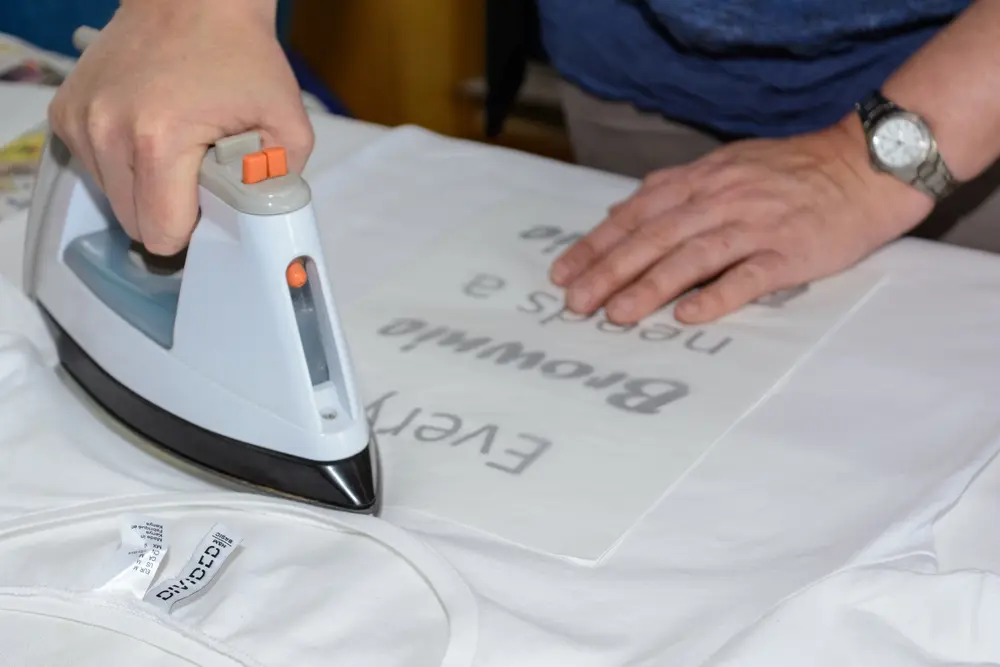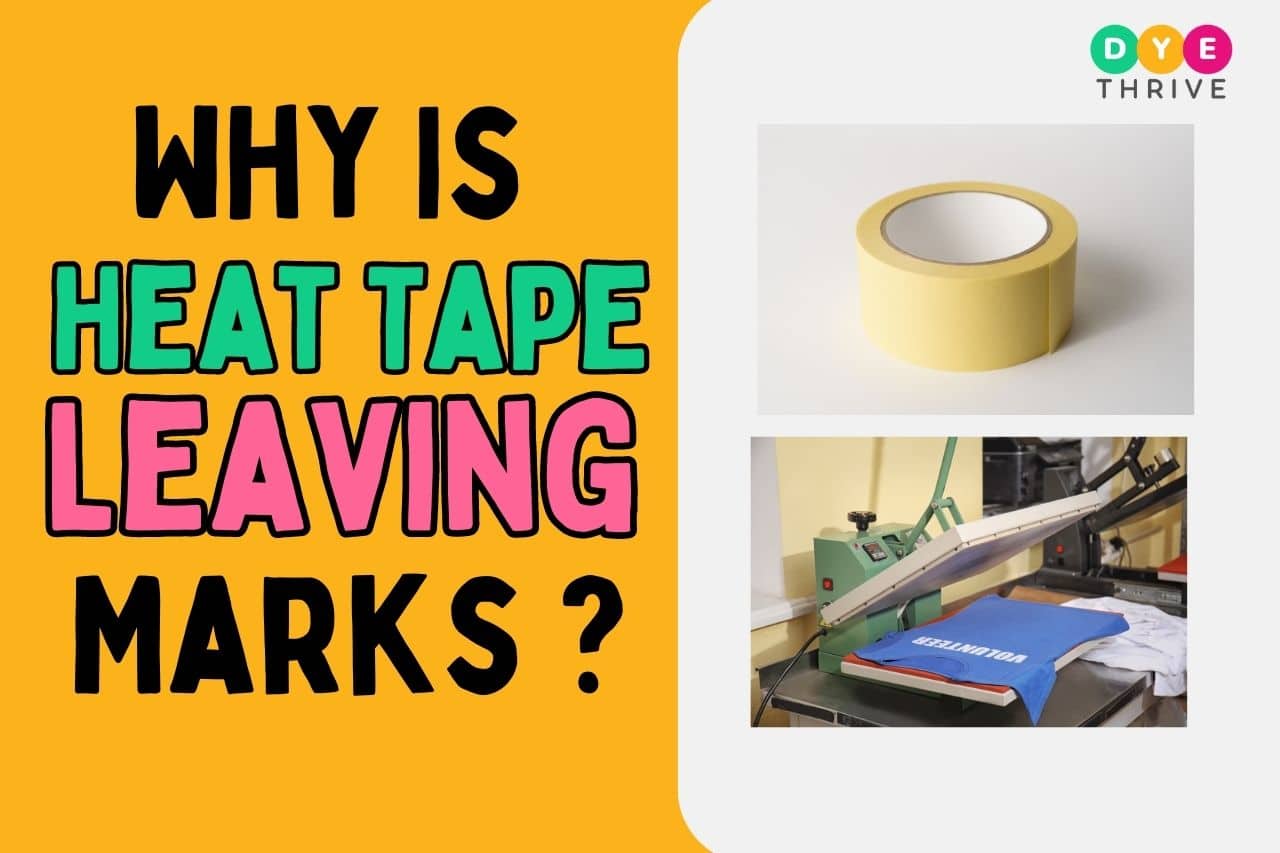Hey there, my awesome sublimation and printing peeps!
So, picture this: you’re all pumped up to create a killer sublimation masterpiece, and you carefully place your heat tape to secure everything in place.
But wait… what’s that? Oh no!
You spot those annoying marks left behind by the very tape that’s supposed to make your prints perfect!
Ugh, talk about a buzzkill!
But don’t worry because, in this blog post, I will be telling you the reason why your heat tape is leaving marks and how can you avoid that.
Keep reading—we’re about to make those pesky heat tape stains a thing of the past!
Key Takeaways
Why Is My Heat Tape Leaving Marks
Heat tape leaves marks due to factors such as heat transfer, poor quality tape, and improper application methods.
1. Heat transfer
Heat transfer is a significant factor contributing to unsightly marks left by heat tape.
It’s all about the balance of temperature and time.
Excessive heat or prolonged exposure can cause the fabric to discolor, stain, scorch or even burn, especially if you’re working on fabrics or ceramics which are sensitive to high temperatures.

And guess what? This could also lead to those stubborn yellow marks from heat tape that ruin the aesthetics of your items.
While using quality sublimation tape for high temperature applications helps prevent these issues, correct adjustment of temperature settings plays an equally important role in maintaining the look and integrity of your projects.
Plus, it lowers the risk of damaging your pieces while removing any potential residue from improper heating practices.
2. Poor quality tape
Using poor quality tape is one of the main reasons why heat tape can leave marks on your projects. When the tape is made with low-quality materials, it may not be able to withstand high temperatures and can easily melt or discolor.
This can result in unsightly marks on your fabrics or other surfaces. It’s important to invest in a good brand of heat-resistant tape that is specifically designed for high-temperature applications.
By using a higher quality tape, you can ensure that it will effectively protect your materials without leaving any unwanted marks behind.
3. Improper method of application
Using heat tape incorrectly can also lead to marks on your projects. Improperly applying the tape can cause it to leave behind residue or stains.
Make sure to clean and dry the surface before applying the tape, as any dirt or moisture can affect its adhesion.
Additionally, be cautious of how much pressure you apply when using heat tape. Applying too much pressure can cause the adhesive to spread and create visible marks once removed.
To prevent this, lightly press down on the tape without exerting excessive force.
Another important consideration is avoiding overlapping of heat tape.
When layering multiple strips of tape, ensure that they are evenly spaced and not overlapping each other.
Overlapping can create uneven heating and result in unwanted marks or lines on your project.
Preventing Heat Tape Marks
To prevent heat tape marks, make sure to use high-quality and correct tape for the job. Adjust the temperature and time settings on your heat press machine appropriately. And for added protection, consider using protective sheets when applying heat tape.
1. Use high-quality and correct tape
When it comes to preventing heat tape marks, using high-quality and correct tape is crucial. Here’s why:
- Investing in a good brand of heat – resistant tape can make a significant difference in preventing tape marks. Look for brands that are known for their quality and durability.
- Make sure to choose the correct type of tape for your specific application. Different materials and surfaces may require different types of heat-resistant tape.
- Consider using sublimation tape for projects that involve high temperatures. Sublimation tape is specially designed to withstand heat without leaving any marks or residue.
- Read reviews and compare the performance of different brands of heat – resistant tape before making a purchase. This can help you find the best option for your needs.
- It’s also important to store your heat tape properly. Store it in a cool, dry place away from direct sunlight, as excessive heat exposure can affect its adhesive properties.
2. Adjust temperature and time settings
To prevent heat tape marks, it’s essential to adjust your temperature and time settings correctly. Here’s how:
- Ensure that you are using the recommended temperature and time settings for your specific project. Refer to the instructions provided by the manufacturer or consult an expert if necessary.
- Start with a lower temperature and shorter time duration, and gradually increase if needed. This will help you find the ideal settings for your particular materials without causing any damage or leaving marks.
- Keep in mind that different materials require different temperature and time settings. For example, sublimation on ceramic may require higher temperatures compared to sublimation on fabric.
- Regularly monitor the heat press machine’s thermometer to ensure accurate readings. Fluctuations in temperature might lead to uneven heat distribution, resulting in marks or discoloration.
- If you notice any signs of scorching or burning, immediately reduce the temperature and adjust accordingly. It is better to err on the side of caution rather than risk ruining your project with unwanted marks.
3. Use protective sheets
To prevent heat tape marks, it’s important to use protective sheets. These sheets act as a barrier between the heat tape and the surface you’re working on, preventing any residue or adhesive from transferring onto your project.
By placing a protective sheet over your material before applying the heat tape, you can ensure that no marks are left behind once the tape is removed. This simple step can make a big difference in achieving a clean and professional finish for your sublimation projects.
Removing Heat Tape Marks
Removing heat tape marks can be a challenging task, especially when dealing with different materials like synthetic fabric, metals, and ceramics.
Discover effective methods for removing these unsightly marks and restoring the appearance of your items.
Synthetic fabric
Synthetic fabrics like polyester, nylon, and rayon are commonly used in clothing and other textile products.
When heat tape is applied to synthetic fabric during a sublimation or heat transfer process, it can sometimes leave marks or residue behind.
Here are some important things to know about dealing with heat tape marks on synthetic fabric:
- Choose the right tape: Use a high-quality heat-resistant tape that is specifically designed for use on synthetic fabrics. These tapes are often made with materials that can withstand high temperatures without leaving marks.
- Test the temperature and time settings: Adjusting the temperature and time settings on your heat press or sublimation machine can help prevent heat tape marks. Make sure you are using the recommended settings for the type of fabric you are working with.
- Protect your fabric: Place a protective sheet or Teflon cover over your fabric before applying heat tape. This will create a barrier between the fabric and the tape, reducing the risk of marks or residue.
- Remove gently: When removing heat tape from synthetic fabric, do it carefully to avoid leaving any adhesive residue behind.
Slowly peel off the tape at a 45-degree angle, ensuring that it doesn’t pull or snag on the fabric. - Consider alternative methods: If you continue to experience issues with heat tape marks on synthetic fabric, you may want to explore other methods of securing your design during the sublimation process. This could include using adhesive sprays or transfer paper instead of tape.
Metals (aluminum, stainless steel, iron)
Metal surfaces, such as aluminum, stainless steel, and iron, can be prone to heat tape marks if not properly protected. Here are some key points to remember when dealing with heat tape on metal:
- Ensure the metal surface is clean and free from any dirt or debris before applying heat tape.
- Use a high-quality heat-resistant tape specifically designed for metal surfaces to minimize the risk of marks.
- Avoid using excessive heat or pressure during the application process to prevent scorching or melting of the tape onto the metal.
- If you notice any yellowing or discoloration after removing the tape, try using a mild solvent or adhesive remover recommended for use on metals to gently remove any residue.
- Test a small inconspicuous area first before applying any solvents to ensure they do not damage or corrode the metal surface.
- It’s important to note that removing heat tape marks from metal surfaces can be challenging, and in some cases, it may not be completely possible to eliminate them entirely.
Conclusion
Understanding why your heat tape is leaving marks is crucial for achieving flawless results in your projects. Factors such as heat transfer, poor quality tape, and improper application methods can contribute to these unsightly marks.
By using high-quality tape, adjusting temperature settings appropriately, and employing protective sheets when necessary, you can prevent heat tape marks from occurring.
Remember to choose the right type of tape for different materials and utilize sublimation-specific options for higher temperature applications.
With the right precautions in place, you can ensure a seamless finish without any unwanted residue or stains on your creations.




